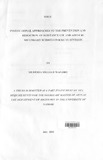| dc.description.abstract | The main objective of this study was to examine the institutional approaches being used in selected schools to prevent and reduce substance use and abuse and to discern their effectiveness. The study also identified factors undermining the effectiveness of the approaches. The study assumed that these constraints/challenges affected the effectiveness of the preferred approaches to prevention and reduction of substance use and abuse in schools.
To achieve the objectives of the study, a research was conducted among secondary school students and teachers within Kikuyu Division of Kiambu West District in Central Province of the Republic of Kenya. The survey was the primary method of data collection. Both qualitative and quantitative data were collected using interview schedules consisting of fixed and open-ended-questions administered in face-to-face interviews. Stratified random sampling method was used to select the samples for the study, that is, I I schools (categorized as girls' boys' and mixed schools), 209 students and 18 teachers. The quantitative data were analysed using the Statistical Package for Social Sciences (SPSS) computer package while the qualitative data were analysed manually.
The study showed that a number of approaches were being used in secondary schools to prevent and reduce substance use and abuse, the major ones being: inviting guest speakers in schools to speak on the subject of substances and teachers educating students on dangers of substance use. The other finding was that most of the approaches used were generally effective, with the most effective one being that of counseling of students found using substances. Unfortunately, there were a number of constraints/challenges that faced the prevention and reduction of substance use and abuse in the schools and the key ones included peer pressure, ignorance and inadequate guidance and counseling teachers. However, from the findings of the study, there were viable ways through which the constraints/challenges could be addressed. The key ones included the increase of the number of guidance and counseling teachers and the increase of drug rehabilitation centres.
This study concluded that there were institutional approaches that were being used in the prevention and reduction of substance use and abuse in secondary schools in Kikuyu Division and that these approaches were generally effective. However, the effectiveness of the approaches used was being hampered by a number of constraints/challenges. This study recommends that the approaches used in the prevention and reduction of substance use and abuse in secondary schools be maintained and the challenges/constraints be addressed for example, by recruiting more qualified guidance and counseling teachers and increasing the number of affordable substance abuse rehabilitation centres. Stakeholders in the problem of substance abuse and use in schools such as the Ministry of Education and Provincial administration need to playa leading role especially in curbing the supply of illicit drugs and substances in schools and in the general community. | en_US |

